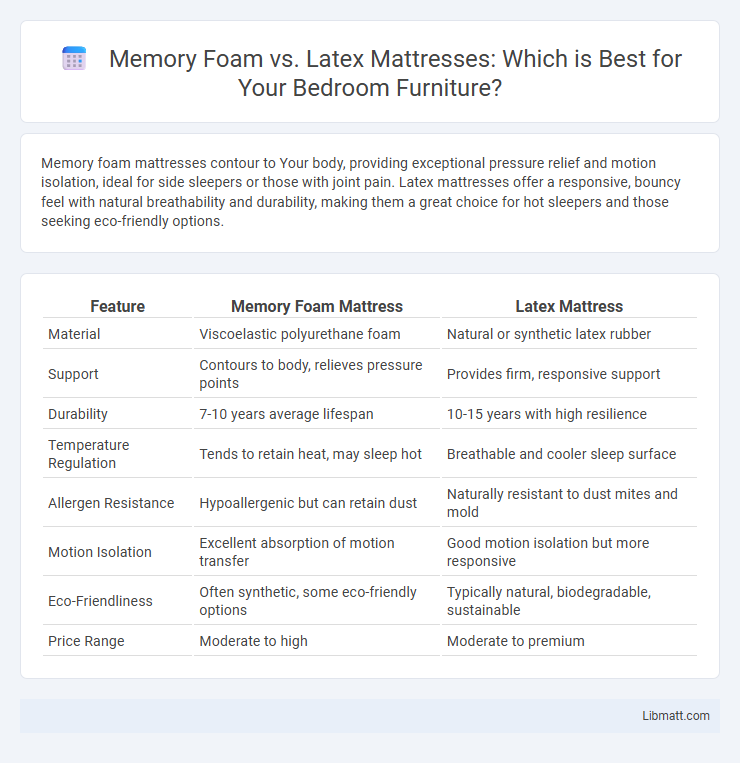Memory foam mattresses contour to Your body, providing exceptional pressure relief and motion isolation, ideal for side sleepers or those with joint pain. Latex mattresses offer a responsive, bouncy feel with natural breathability and durability, making them a great choice for hot sleepers and those seeking eco-friendly options.
Table of Comparison
| Feature | Memory Foam Mattress | Latex Mattress |
|---|---|---|
| Material | Viscoelastic polyurethane foam | Natural or synthetic latex rubber |
| Support | Contours to body, relieves pressure points | Provides firm, responsive support |
| Durability | 7-10 years average lifespan | 10-15 years with high resilience |
| Temperature Regulation | Tends to retain heat, may sleep hot | Breathable and cooler sleep surface |
| Allergen Resistance | Hypoallergenic but can retain dust | Naturally resistant to dust mites and mold |
| Motion Isolation | Excellent absorption of motion transfer | Good motion isolation but more responsive |
| Eco-Friendliness | Often synthetic, some eco-friendly options | Typically natural, biodegradable, sustainable |
| Price Range | Moderate to high | Moderate to premium |
Introduction: Memory Foam vs Latex Mattress
Memory foam mattresses, composed of viscoelastic polyurethane, are known for their pressure-relieving properties and contouring support that adapts to body shape and temperature. Latex mattresses, derived from natural or synthetic rubber, provide a responsive, bouncy feel with excellent durability and natural hypoallergenic features. Choosing between memory foam and latex depends on factors like sleep position, temperature regulation preferences, and allergen sensitivity.
What Is a Memory Foam Mattress?
A memory foam mattress is designed using viscoelastic polyurethane foam that contours closely to the body, providing pressure relief and support by evenly distributing weight. This type of mattress absorbs movement, making it ideal for couples by minimizing sleep disturbances. Memory foam mattresses are temperature-sensitive, softening with body heat to enhance comfort and reduce motion transfer.
What Is a Latex Mattress?
A latex mattress is crafted from natural or synthetic latex foam, known for its durability, responsiveness, and eco-friendly properties. It offers superior support by contouring to your body while maintaining breathability and temperature regulation, making it ideal for those seeking a cooler sleep experience. Compared to memory foam, latex mattresses often provide a bouncier feel with less heat retention, benefiting people who prioritize resilience and natural materials.
Key Differences Between Memory Foam and Latex Mattresses
Memory foam mattresses contour closely to the body, providing pressure relief and excellent motion isolation, making them ideal for side sleepers and those with joint pain. Latex mattresses offer a responsive, bouncy feel with superior breathability and durability, preferred by sleepers who need enhanced airflow and natural materials. The key differences lie in material composition, firmness options, temperature regulation, and allergenic properties, with memory foam often retaining heat and latex being naturally hypoallergenic.
Comfort and Support Comparison
Memory foam mattresses contour to your body, providing pressure relief and cradling support that adapts to your sleep position for personalized comfort. Latex mattresses offer responsive support with natural elasticity that maintains spinal alignment while promoting airflow for a cooler sleep experience. Your choice between these materials depends on whether you prioritize deep body sinking and pressure alleviation or resilient bounce and temperature regulation.
Durability and Lifespan
Memory foam mattresses typically offer a lifespan of 7 to 10 years, with durability influenced by foam density and usage patterns. Latex mattresses, especially natural latex, are known for superior durability, often lasting 12 to 15 years or more due to their resilient, hypoallergenic properties. Choosing a latex mattress can provide your sleep setup with enhanced longevity and consistent support over time.
Temperature Regulation and Breathability
Memory foam mattresses offer excellent contouring and pressure relief but can retain heat, making them less breathable and warmer for some sleepers. Latex mattresses provide superior temperature regulation due to their naturally breathable, open-cell structure, which promotes airflow and helps dissipate heat efficiently. Choosing a latex mattress can improve your sleep comfort by maintaining a cooler, more ventilated sleep environment.
Motion Isolation and Noise
Memory foam mattresses provide superior motion isolation by absorbing movement and preventing it from transferring across the bed, making them ideal for couples who are easily disturbed by partner movements. Latex mattresses tend to have a more responsive surface, which may result in slightly increased motion transfer compared to memory foam but still offer moderate noise levels due to their natural materials. Both mattress types are generally quiet, with memory foam being virtually noise-free and latex producing minimal to no squeaking or creaking sounds during use.
Eco-Friendliness and Health Considerations
Memory foam mattresses often contain synthetic chemicals and off-gas volatile organic compounds (VOCs), which may impact indoor air quality and trigger allergies. Latex mattresses, especially those made from natural or organic latex, are more eco-friendly due to renewable materials and biodegradability, offering hypoallergenic and antimicrobial properties beneficial for Your health. Choosing a latex mattress supports sustainable practices and reduces potential exposure to harmful chemicals, making it a healthier option overall.
Which Mattress Is Best for You?
Memory foam mattresses contour closely to your body, providing excellent pressure relief and motion isolation, ideal for side sleepers or those with joint pain. Latex mattresses offer a more responsive and breathable surface, promoting better air circulation and durability, suitable for hot sleepers and those who prefer a firmer feel. Your choice depends on your sleep preferences, body support needs, and whether you prioritize temperature regulation or contouring comfort.
Memory Foam vs Latex Mattress Infographic

 libmatt.com
libmatt.com